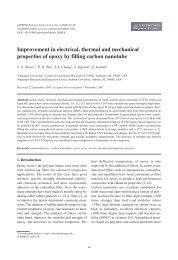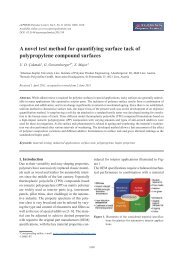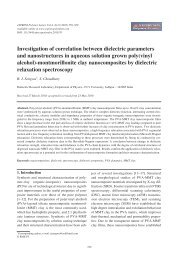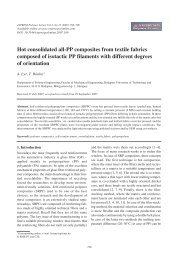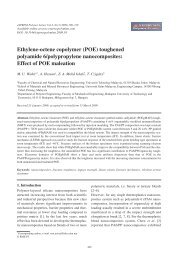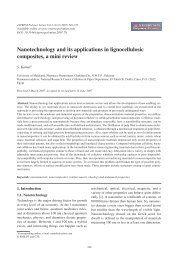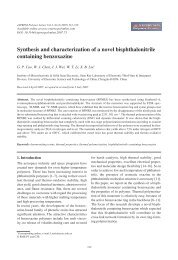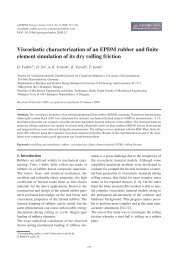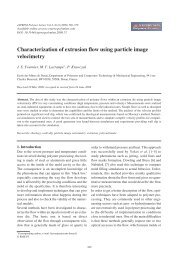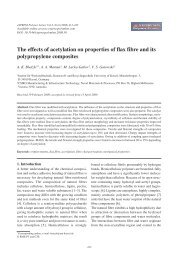Starch-based completely biodegradable polymer materials
Starch-based completely biodegradable polymer materials
Starch-based completely biodegradable polymer materials
Create successful ePaper yourself
Turn your PDF publications into a flip-book with our unique Google optimized e-Paper software.
Lu et al. – eXPRESS Polymer Letters Vol.3, No.6 (2009) 366–375<br />
trolled release <strong>materials</strong> [66]. The consumption of<br />
agriculture films is abundant. Generally, the disposal<br />
methods of tradition films are landfill, recycling<br />
or burning. But they are time-consuming, not<br />
economic and lead to environmental pollution [67].<br />
On the other hand, the utilization efficiency of fertilizers<br />
is the key element of the development of<br />
agricultural productions. However, due to surface<br />
runoff, leaching and vaporization, the fertilizers<br />
escape to environment to cause diseconomy and<br />
environmental problems [68, 69].<br />
The development of starch-<strong>based</strong> <strong>biodegradable</strong><br />
<strong>polymer</strong>s offers a possibility to overcome the mentioned<br />
problems. They can be used as the fertilizers<br />
controlled release matrices to release the fertilizers<br />
slowly or in controlled way. As a result, the loss of<br />
fertilizers and environment pollution can be<br />
avoided or reduced [50, 70].<br />
After using, starch-<strong>based</strong> films can be ploughed<br />
into soil and disposed directly. Moreover, no toxic<br />
residues formed after the degradation of starch<strong>based</strong><br />
<strong>biodegradable</strong> <strong>polymer</strong>s [71, 72]. Thus, the<br />
development of starch-<strong>based</strong> <strong>materials</strong> for agriculture<br />
applications is being continued. For example,<br />
to enhance the mechanical properties and solvent or<br />
gas resistance, starch-<strong>based</strong> <strong>biodegradable</strong> <strong>materials</strong><br />
are mixed with some nano-grade additives such<br />
as TiO 2 , layered silicate and MMT to form bionanocomposites<br />
[73–75].<br />
Figure 2. SEM photograph of strach-g-PVA/HA hydrogel<br />
(scale bar 3 µm)<br />
4.3. In medical field<br />
<strong>Starch</strong>-<strong>based</strong> biodegradeable <strong>polymer</strong>s have some<br />
advantages to be medical <strong>polymer</strong> <strong>materials</strong><br />
[76–81]:<br />
a) good biocompatibility<br />
b) <strong>biodegradable</strong> and its degradation products are<br />
non-toxic<br />
c) proper mechanical properties<br />
d) degradation as requirement<br />
<strong>Starch</strong>-<strong>based</strong> biodegradeable <strong>polymer</strong>s have been<br />
widely investigated in bone tissue engineering.<br />
<strong>Starch</strong>-<strong>based</strong> <strong>biodegradable</strong> bone cements can provide<br />
immediate structural support and degrade<br />
from the site of application. Moreover, they can be<br />
combined with bioactive particles, which allow<br />
new bone growth to be induced in both the interface<br />
of cement-bone and the volume left by <strong>polymer</strong><br />
degradation [82]. In addition, starch-<strong>based</strong> biodegradeable<br />
<strong>polymer</strong> can also be used as bone tissue<br />
engineering scaffold [83].<br />
<strong>Starch</strong>-<strong>based</strong> <strong>biodegradable</strong> <strong>polymer</strong>s, in the form<br />
of microsphere or hydrogel, are suitable for drug<br />
delivery [84, 85]. There is no need for surgical<br />
removal of the device after drug depletion.<br />
The unique properties, such as hydrophilicity, permeability,<br />
biocompatibility, and to some extent<br />
similar to soft biological systems, of starch-<strong>based</strong><br />
hydrogels make them useful for various biomedical<br />
applications [86]. The 3D structure of starch-<strong>based</strong><br />
hydrogels enable them absorb and reserve a plenty<br />
of water and keep good enough mechanical property<br />
at the same time. <strong>Starch</strong>-<strong>based</strong> hydrogels have<br />
received growing interest for biomedical applications.<br />
In our lab, physically cross-linked starch-g-<br />
PVA and starch-g-PVA/hydroxyapatite hydrogel<br />
are obtained via repeated freezing/thawing circles,<br />
and hydroxyapatite (HA) can be well dispersed in<br />
such a matrix (Figure 2) [55, 87]. The water content<br />
in the fresh starch-g-PVA/HA hydrogel is comparable<br />
to that of PVA/HA hydrogel, and the dried<br />
starch-g-PVA/HA films can re-adsorb water soon<br />
and reach swelling equilibrium within 12 minutes.<br />
5. Conclusions<br />
<strong>Starch</strong> is renewable from carbon dioxide, water and<br />
sunshine. It is <strong>biodegradable</strong>, cheap and to be physical<br />
or chemical modified easily. This means someday<br />
it is unnecessary to rely on petroleum to<br />
371




